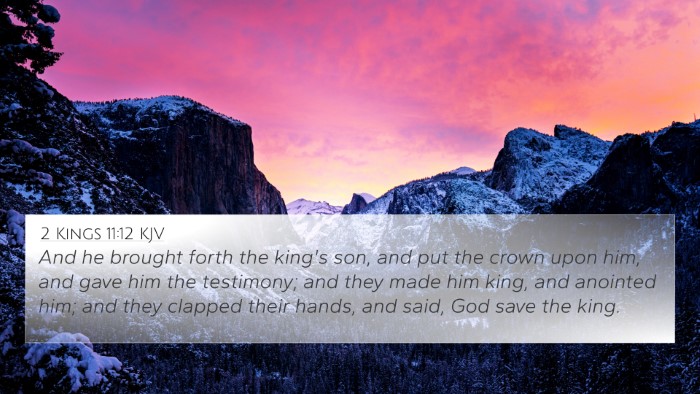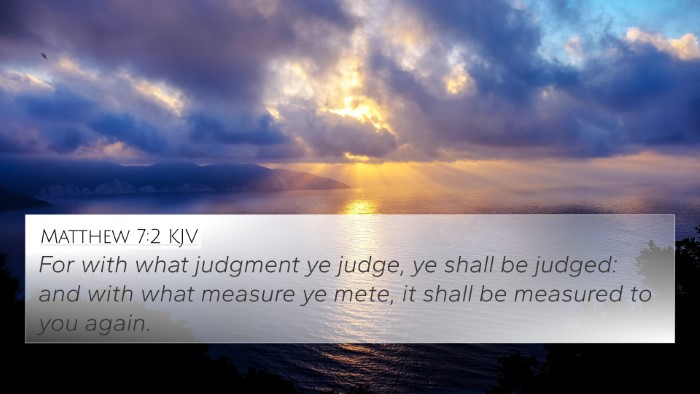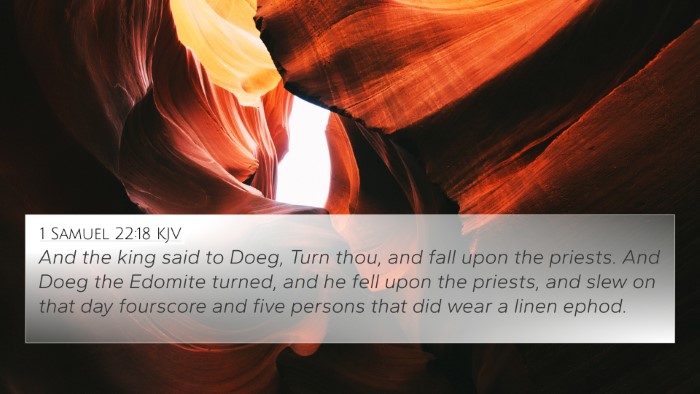Understanding 2 Samuel 1:10
2 Samuel 1:10 states, "So I stood beside him and killed him, because I was sure that he could not live after he had fallen. And I took the crown that was on his head and the armlet that was on his arm, and I brought them here to my lord." This verse takes place after the death of King Saul and shows an act that ultimately leads to unforeseen consequences.
This verse can be interpreted through various public domain commentaries such as those by Matthew Henry, Albert Barnes, and Adam Clarke. Together, their insights provide a richer context and understanding:
Commentary Insights
- Matthew Henry: Henry emphasizes the treachery in the man's act of killing Saul. He highlights how this action, which he believed would please David, ultimately resulted in his death because David sees it as a grave sin against God's anointed. The verse illustrates the principle of respecting God's chosen leaders and the consequences of acting out of self-interest.
- Albert Barnes: Barnes suggests that the Amalekite's act showcases both the desperation of the individual and the misguided way in which people often seek favor through such actions. Saul's fall is interpreted as a tragedy, and the killing symbolizes a deeper moral decay. Barnes connects this to the idea of how one can misinterpret the situation, assuming that David would reward him, not knowing David’s loyalty to Saul.
- Adam Clarke: Clarke provides a historical perspective, suggesting that the Amalekite's claims about Saul's death might be exaggerated or false. He notes that this man's perception of David as a merciful leader leads him into his downfall. Clarke’s view emphasizes the importance of truth and the reliance on honesty when seeking favor.
Bible Cross References for 2 Samuel 1:10
- 1 Samuel 15:3 - God's command to Saul regarding the Amalekites.
- 1 Samuel 31:4 - Saul’s death by falling on his sword.
- 2 Samuel 4:10 - The fate of the one who claimed to kill Saul.
- 1 Chronicles 10:13-14 - Explanation of Saul's death as judgment from God.
- Romans 13:1 - The principle of submission to governing authorities, which connects to David's respect for Saul.
- Psalms 105:15 - God's admonition against harming His anointed ones.
- 2 Samuel 1:14-16 - David's reaction to the Amalekite's claim.
Connections and Themes
The themes within this verse connect to:
- Divine Sovereignty: Recognizing God's control over the fate of leaders.
- Moral Responsibility: The individual's duty to act righteously and honorably.
- The Dangers of Ambition: How the desire for recognition can lead to one's downfall.
- Truth and Deception: The necessity of honesty in actions and motives
Further Study and Interpretation
To delve deeper into 2 Samuel 1:10 and its implications, one may consider engaging in cross-referencing Bible study methods. Here are some tools and techniques:
- Utilize a Bible concordance to find related passages efficiently.
- Cross-reference resources can facilitate comparing passages across different books.
- Employ a cross-reference guide to discover thematic linkages between verses.
- Engage in a comprehensive Bible cross-reference method that encourages setting verses into thematic categories.
Concluding Thoughts
2 Samuel 1:10 not only tells the story of a miscalculation from the Amalekite but serves as a cautionary tale about the ramifications of pride and the violation of divine law. Through connecting this verse with others, one can see how biblical truths resonate throughout the scriptures, highlighting common themes of loyalty, divine justice, and the moral responsibilities that leaders carry, which echo throughout both testaments.
The exploration of cross-references here serves to illustrate the depth of biblical understanding and encourages readers to seek out the rich tapestry of connections that exist among the texts. By recognizing these themes and studying them in conjunction with other passages, individuals can gain insights into their faith and understand the greater narrative of Scripture.










